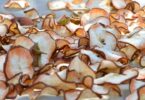In this article, I am going to share with you the easiest methods of dehydrating blueberries … and how to store dried blueberries.
Blueberries are easy to dehydrate, unlike other fruits as they do not require much preparation, blanching, sugar, and preservatives.
READ ALSO: 7 Health Benefits of Dried Blueberries
How to Dehydrate Blueberries
Dehydrating blueberries can be done in any of the following ways:
- Sun-drying blueberries – This is the most traditional and natural way of dehydrating fruits. It was used in ancient Egypt and Mesopotamia. This method is very cheap since the process relies solely on the sun. The downside of this is that it requires a long time to fully finish the process of drying, and this usually works in countries that have hot summers. This method requires 3-4 days at 100 degrees in a row so if your area does not get hot enough during summer, this method may not be impossible.
- Dehydrating blueberries in the dehydrator – Using a food dehydrator is a simple and fast way to dehydrate fruits, and it also gives the best results. A food dehydrator is an appliance that is used to get rid of moisture from the fruits, vegetables, and meats in order to preserve them. The food dehydrator minimizes the water content of foods through the use of a heat source and airflow. The water content of fruits is usually around the range of 80-95%. Moisture, when prolonged, causes bacteria to grow and can trigger rotting in the food. That’s why the process of eliminating the moisture from the food helps extend its lifespan.
- Using an oven – This is the same oven that you also use for baking. On the other hand, this is not commonly used for dehydrating fruits, but it can also count as an option when you don’t want to spend a big amount of money for a food dehydrator or if you’re in a cold country where sun drying won’t work. This method is not energy efficient since you’re going to need to keep the oven below 200 degrees Fahrenheit while having the oven door open to circulate the air. It’s recommended to have them on a mesh baking rack, but a cookie sheet can also do.
The general process for dehydrating blueberries
1. When dehydrating blueberries, you will be needing a pack of blueberries. Since there’s no use of sugar involved, focus on finding the ones with the best quality, such as the ones that are sweet, firm, plump, dry, and smooth-skinned. They should have the color purple-blue or blue-black. It’s best when it is fresh to ensure good quality in taste.
2. Wash the blueberries with clean water. Dry them thoroughly afterward if you want the process to be faster, especially when you plan to use a dehydrator.
3. Remove the leaves and stems of the blueberries.
4. Make sure to eliminate the rotten and bruised ones.
5. Gently plunge the blueberries into boiling water for 25-30 seconds. No need to stir. Just leave them there undisturbed.
6. Pick up the blueberries from the boiling water preferably by using a slotted spoon. Then, feel the blueberries if they are soft.
7. Soak the blueberries into icy cold water for a minute.
8. It is recommended to poke a small hole in each blueberry. It may be tedious, but this makes the process of dehydrating blueberries quicker to finish.
After this, you can either opt for sun-drying method, use of food dehydrator, or electric oven.
Sun-drying blueberries
- To sun dry your blueberries, you place the berries on a non-metallic framed screen. If you use something metallic, it will react with the natural acids.
- Keep in mind to cover the screen or tray with a cloth to keep insects away, and avoid bird droppings.
- This will only work during a hot summer day since this method requires sunshine. There should also be low humidity and good air circulation.
- Take the tray inside each night.
- In case it rains, remember to bring the tray inside and bring it back outside when the rain has subsided.
After around 3-4 days, the blueberries will already be dried.
Dehydrating blueberries in a food dehydrator
- The first step on dehydrating blueberries using a dehydrator is to place the blueberries on the dehydrator trays in a single layer.
- It’s a fact that when food is dehydrated, it shrinks. That is why it is recommended to place a screen on the tray to avoid the blueberries from falling through the trays when they shrink.
- It is best to set the temperature of the dehydrator low in order to prevent getting the blueberries burnt. Setting the temperature to 115 degrees is a good option.
- Allow the blueberries to dehydrate for 18 to 24 hours.
Here is a nice short video about dehydrating blueberries in the food dehydrator:
Dehydrating blueberries in oven
- To dehydrate the blueberries in an electric oven, you will need to put the blueberries first on a cookie sheet lined with parchment paper.
- Preheat oven to 135 degrees Fahrenheit.
- Along with the cookie sheet lined with parchment paper, bake the blueberries in the electric oven for 10 hours at 135 degrees Fahrenheit.
If you want to reduce the time of baking the blueberries to around 7 hours, turn the heat to 200 degrees instead of 135. Just make sure that you check on them frequently.
To know if the blueberries are already dried up, squeeze them and check if there’s a minimal squishy feeling left.
How to store dried blueberries
- Pack the blueberries into an air-tight container when they are already completely dried and are already cooled down into room temperature. It is best to use glass since glass does not react with the blueberries’ acids.
- Store them in a cool, dark place to prolong their shelf life.
- To rehydrate blueberries, soak them in the water for several minutes to around 30 minutes.
READ ALSO: How to Store Dried Blueberries





